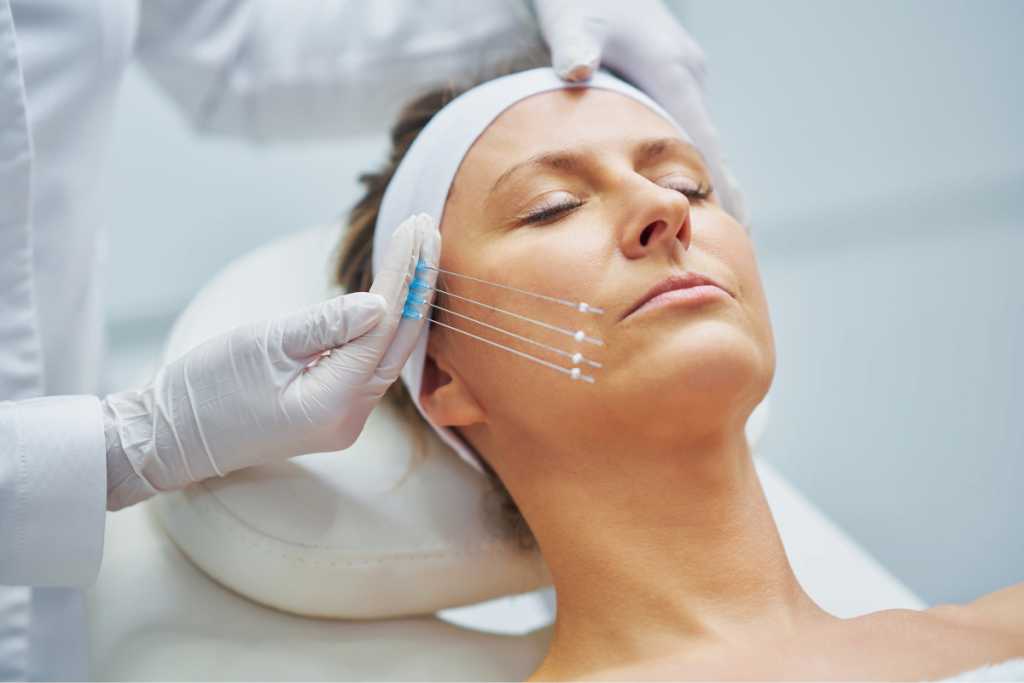Thread lifting is a minimally invasive aesthetic procedure that uses suture-based devices to reposition soft tissue. Many practices use absorbable polydioxanone (PDO) materials, alongside other thread designs. Before offering the service, clinics should understand the disadvantages of thread lift and how those risks show up operationally. That includes consent, documentation, follow-up cadence, and how you source regulated devices.
This guide is written for licensed healthcare teams. It focuses on practical risk framing, common failure modes, and clinic workflow controls. It does not replace training, manufacturer instructions, or your facility’s protocols.
Key Takeaways
- Set realistic lift and longevity expectations early.
- Separate normal recovery findings from escalation triggers.
- Plan for asymmetry, palpability, and visibility discussions.
- Standardize device traceability and photo documentation.
- Compare threads against fillers, toxin, and surgery thoughtfully.
MedWholesaleSupplies supplies verified healthcare accounts, not direct-to-consumer purchasers.
Mapping The disadvantages of thread lift In Practice
When clinicians discuss “downsides,” they often mix technical risks with expectation gaps. It helps to separate three categories: (1) procedural complications, (2) early recovery issues, and (3) limitations of what threads can achieve. In many cases, dissatisfaction is not a “complication” in the classic sense. It is a mismatch between expected lift and what a suture-based vector can deliver without excision.
Common procedural risks can include bruising (ecchymosis), swelling (edema), discomfort, bleeding, infection, and short-term dimpling or contour irregularity. Deeper, less common events may involve nerve irritation, salivary duct injury, or vascular compromise, depending on anatomy and technique. Device-related issues can include breakage, malposition, or migration. Your consent language should reflect that outcomes vary and that revision, removal, or alternative treatments may be needed.
Why it matters: Clear risk framing reduces escalations when “normal” healing looks dramatic.
From an operations viewpoint, plan for variability. Build a follow-up process that can handle unexpected swelling at day 10, discomfort at week 2, or an asymmetry complaint at month 3. Also plan for documentation quality. Thread lift outcomes can be subtle, and subtle outcomes are easier to dispute if photos are inconsistent.
For background refreshers your team can align on, see What Are PDO Threads and Facial Rejuvenation With PDO Thread Lifts.
What “Thread Lift Gone Wrong” Looks Like Clinically
In practice, “thread lift gone wrong” is an umbrella phrase. It can refer to a true adverse event, a suboptimal aesthetic result, or a normal but unexpected recovery appearance. Your team will manage these differently. The first step is to classify the complaint: symptom-driven (pain, heat, drainage), appearance-driven (asymmetry, bunching), or sensation-driven (tightness, foreign-body feeling).
As part of that classification, consider the setting. Posts labeled “thread lift horror stories” online often lack exam findings, device details, or timelines. They can still be useful as a reminder of perception risk. But they are not a substitute for complication tracking, standardized photography, and a clear “who calls whom” pathway after the procedure.
Mechanism-Based Categories You Can Use Internally
Mechanism-based sorting makes case review easier. Mechanical issues include superficial placement causing visibility, thread extrusion (a thread end showing through skin), anchoring failure, or vector mismatch leading to asymmetry. Tissue-response issues include prolonged inflammation, infection, or persistent nodularity (small, firm lumps). A third bucket is “expectation mismatch,” where the lift is modest or short-lived compared with a surgical facelift. Tracking events in these buckets helps you identify whether you have a training gap, a patient-selection issue, or a device-choice issue.
How To Interpret “Gone Wrong” Photos Without Overreacting
Teams often search for “thread lift gone wrong photos” when a patient sends a concerning image. Photos can mislead. Lighting exaggerates swelling and bruising, and wide-angle lenses distort facial proportions. Timepoint matters too; a day-3 photo is not comparable to a week-6 photo. Consider using consistent in-clinic images (same camera, distance, and head position) and anchoring them to documented timelines. This improves internal review and reduces disagreement about what changed.
When discussing complications and limitations, one recurring theme is the disadvantages of thread lift in patients expecting surgical-level tightening. Set that boundary early, in plain language, and repeat it in written consent.
Recovery And Follow-Up: Expected Vs Concerning
Most thread lift aftercare questions your staff receives are about time and visibility: “Is this swelling normal?” “Why do I feel pulling?” “Why does one side look higher?” Clinics can reduce reactive messaging by offering a structured follow-up schedule, a symptom log template, and consistent photo checkpoints.
Many practices hear about swelling 2 weeks after thread lift or 2 weeks after thread lift pain. Those phrases do not automatically indicate an emergency. But they should trigger a structured assessment pathway. Worsening pain, spreading redness (erythema), fever, drainage, or new neurologic symptoms warrant prompt clinical review per your protocol. The key is to avoid ad hoc advice. Use prewritten guidance aligned with the clinician’s preferred evaluation criteria.
| Timepoint | What Patients Often Notice | What Clinics Track |
|---|---|---|
| Days 1–3 | Swelling, bruising, tightness | Pain pattern, symmetry baseline, photo set |
| Week 1 | Visible irregularities, tenderness | Skin changes, entry points, infection screen |
| Weeks 2–3 | Residual swelling, “pulling” sensation | Trend (improving vs worsening), function limits |
| Months 2–3 | Final contour perception, longevity concerns | Outcome documentation, revision discussion triggers |
Quick tip: Use the same photo angles at every visit.
From a documentation lens, patients frequently search for thread lift recovery photos day by day. That tells you what they compare themselves to. Consider providing a clinic-created “what may happen over time” handout that avoids promises and focuses on variability. It can also reduce reliance on social media timelines that may be filtered, unverified, or atypical. If a patient is evaluating thread lift after 3 months, your standardized images and notes are your most defensible record.
When you discuss timeline variability, state the disadvantages of thread lift in operational terms: recovery questions can persist beyond the first week, and some concerns require in-person reassessment rather than messaging.
Clinic Operations: Devices, Documentation, And Traceability
Thread procedures sit at the intersection of technique and supply chain. If outcomes are subtle, documentation quality matters as much as the device. Build a repeatable workflow around product verification, lot tracking, and standardized charting. This is also where your sourcing model influences risk. If you cannot verify origin and integrity, you add avoidable uncertainty to a procedure that already has variability.
MedWholesaleSupplies focuses on authentic, brand-name medical products sourced through vetted distributors.
Workflow Snapshot For Aesthetic Thread Procedures
Policies vary by state, specialty, and facility. Still, many clinics use a consistent sequence so that supplies, consent, and records stay aligned across providers:
- Verify credentials + scope per facility policy.
- Document indication and treatment plan rationale.
- Confirm device selection and expiration details.
- Record lot/serial details for traceability.
- Capture standardized pre- and post-procedure photos.
- Provide written follow-up and escalation pathways.
- Log adverse events and quality-improvement notes.
Stocking decisions also matter. Teams often carry multiple thread geometries (mono, spiral/screw, cog) for different tissue goals. If you’re reviewing options, the PDO Threads Category can help procurement map device types to your training and protocol set. For examples of product families your clinicians may reference during planning, see Intraline PDO Mono M2750, Intraline Spiral S3038, and Intraline PDO Threads Cog Dimension 360.
Include procurement guardrails in your training. The disadvantages of thread lift can be amplified by inconsistent device quality, incomplete IFU awareness, or poor traceability. If you operate across multiple locations, align naming conventions so “cog,” “mono,” and “spiral” mean the same thing in every cart list and note template.
Operationally, many practices prefer predictable US distribution for replenishment planning. Confirm storage conditions and handling requirements with the manufacturer and your supplier.
How To Compare Thread Lifts With Alternatives
Thread procedures often sit between injectables and surgery. That positioning drives both satisfaction risk and operational planning. A helpful comparison frame is: primary goal (lift vs volume vs skin quality), durability expectations, reversibility, and the clinic’s ability to manage follow-up. This is where “permanent thread lift” language can cause problems. Many commonly used materials are absorbable, and results can change as tissue relaxes and the device resorbs. Avoid absolute language in consult materials.
For side-by-side educational context, you can review PDO Threads Vs Botox and Advancements In Dermal Fillers. If your clinicians use branded PDO systems, Mint PDO Threads Overview is a useful orientation piece for staff education.
Cost discussions should also be structured. Patients may ask about thread lift cost, but clinics should translate that into internal cost drivers: device variety and wastage, procedure time, photo and follow-up labor, complication reserves, and revision policies. Track these drivers before scaling. They often determine whether the service line is sustainable and compliant with your documentation standards.
MedWholesaleSupplies supports licensed clinics and healthcare professionals through a controlled-access supply model.
As a final practical lens, build a “compare and consent” paragraph that addresses durability. Many prospective patients ask how long does a thread lift last and search before-and-after galleries. Provide a conservative range statement (“varies by patient and technique”) and emphasize that maintenance plans, alternative treatments, or surgical referral may be appropriate for some goals. That framing reduces the risk that a normal fade is interpreted as failure.
For supply planning adjacent to threads, see Cannulas And Needles Wholesale Guide to align ordering with your procedure kits and documentation needs.
Authoritative Sources
Use these references to ground patient-facing materials and internal training:
- American Society of Plastic Surgeons thread lift overview
- Cleveland Clinic overview of thread lifts
- FDA medical device information and safety context
In day-to-day practice, the disadvantages of thread lift are most manageable when you standardize selection, documentation, and follow-up. Keep your language conservative, your photo process consistent, and your device sourcing traceable.
This content is for informational purposes only and is not a substitute for professional medical advice.






